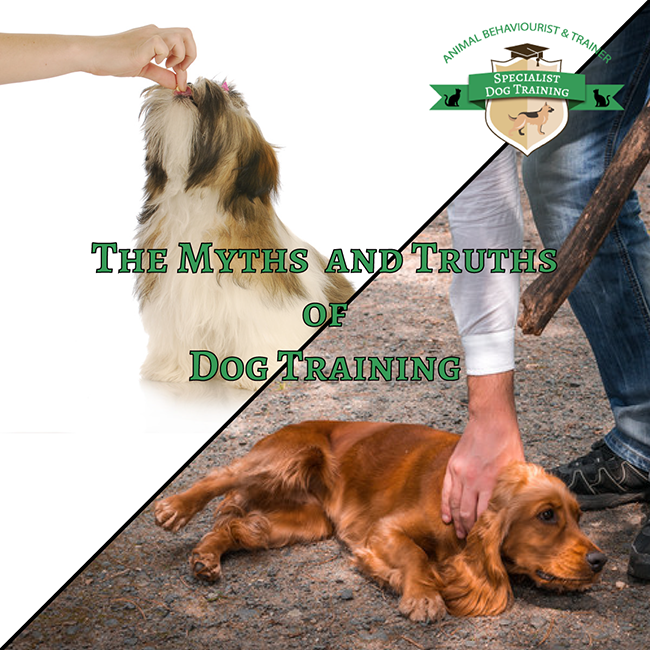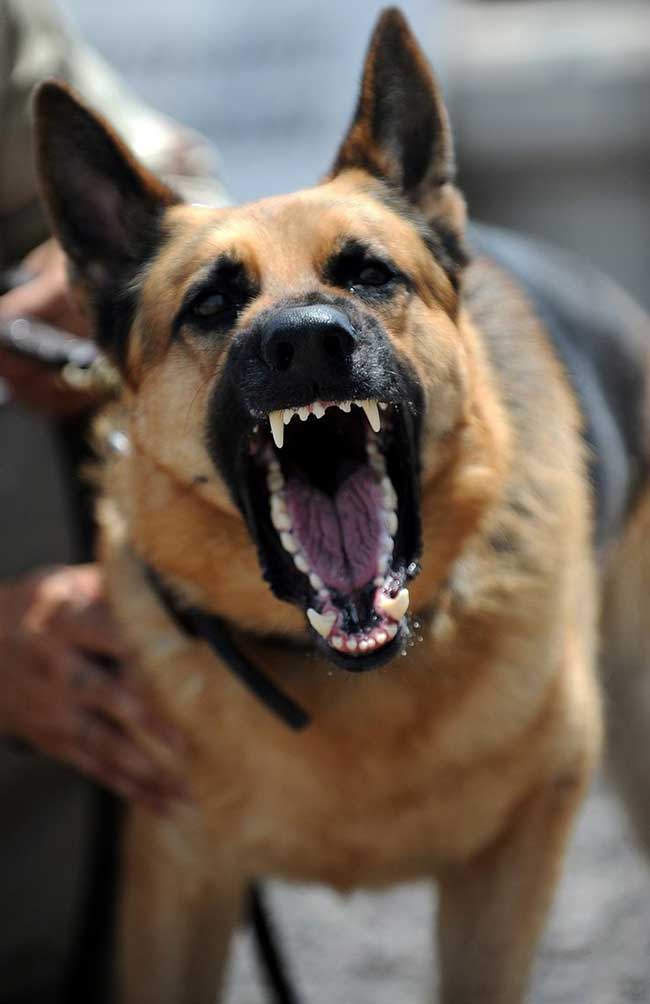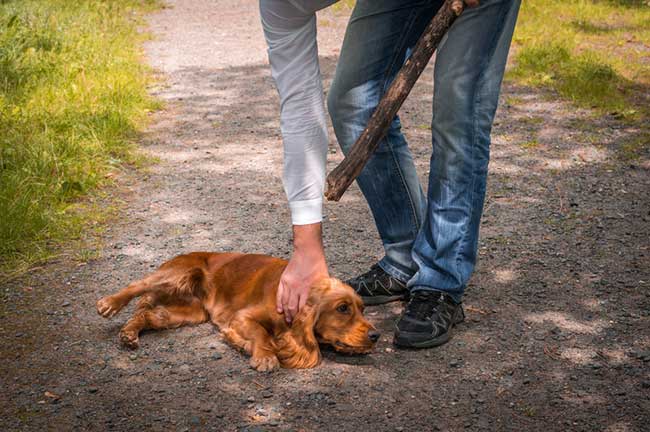
With the scientific advances in dog training and behaviour over the years means that we all know more about our dogs than we ever have before. There always lots of different views on how we should train or act around our dogs.
Television, for one has produced many different concepts and the idea that a dog’s behaviour has been changed with a very short period of time, seems nothing more than miraculous. However, to really train, change and maintain a dog’s behaviour takes a lot more than an episode.
I receive many telephone calls and have discussions with owners over what behaviour their dog is displaying and many of these are often labelled with age old myths, when really the truth is very much different.
So why the confusion? If something has been around for a long time, it tends to stick and takes a long time in re-addressing the balance.
Even today there are two very distinct lines for training your dog, one is the “dominance based alpha leader” style and other is the “positive reward based” style. These two are very different and sit either end of the training scale
.
While it is true that there is more than one way to train a dog, many of the ‘dominance’ style training will do nothing but give your dog a reason to fear you. When it comes to training, it really comes down to you – To what kind of training do you want to use? What kind of owner do you want to be.
Does Punishment even work?
The unfortunate answer to that is – Yes. If you punish a dog for a behaviour you don’t like, with a kick, yank, shock or poke, he will probably stop the behaviour. But all trust will be lost in the process. Every time you ‘Punish’ your dog that trust dwindles, his fear of you grows. You may end up with a fear-filled dog, that may even bite back.
Do you want your dog to trust you or fear you? Both will yield similar results but the journey there is very different.
Only positive training methods lead to a caring healthy and trusting relationships with a balanced dog.
What about aggressive dogs? Can postive training help?

Yes. Postive training actually can work better than other methods. Positive training is not only effective for minor obedience issues but is arguably the most effective way to treat aggressive dogs. Why fight fire with fire?
With postive training a professional dog trainer will be able to change the way dogs feel, effectively curing the cause of the aggression or anxiety rather than simply treating the outer symptoms.
Aggression in dogs is often a symptom of stress or anxiety. We wouldn’t treat anxiety in humans in anything but a sensitive and caring way, so why treat a dog any differently?
The anxiety of the dog needs to be managed effectively. Helping the dog to feel better as well as lessen and eventually cure his aggression. This can take time, but by using postive training techniques the cause of the stress or anxiety is much less likely to return and a trusting relationship is built with your dog during the process.
Don’t dogs need dominate leaders?
Dogs do need leadership from their human owners but this is not always fully understood. The idea of the Alpha is not only outdated but entirely wrong. Even in wolves the alpha doesn’t really exist. Generally in wolf packs the hierarchy is loose and almost entirely determined by the age of the wolf. Older wolves are in-charge in the same way an adult human is in-charge of their children. It is not a position up for debate.
Dogs know we are not the same species as them, so don’t try to pretend to be. Rather than ‘becoming pack-leader’ you simply need to provide consistent positively reinforced leadership. Forget about who is ‘Top Dog’ and instead work on building a rewarding relationship with your dog.
So I shouldn’t discipline my dog at all?
Well that all depends on what you call discipline. Most postive dog training do use discipline. Though in a different way to that of the dominate training. Rather than ‘dominating’ a dig, instead postive trainers use, vocal interrupters, ignoring negative behaviour or removing the item that is causing issue with the dog.
When it comes to dog training there are two forms of punishment:
Positive Punishment
While it may have the word positive in it. Postive Punishment refers to adding something that the dog does not like, to correct the behaviour. Such as physical force or intimidation.
It often involves punishments based around ‘Alpha rolls’ such as holding a dog down until he/she ‘submits’ or pokes which are meant to simulate a ‘bite’ that a dog would use to reprimand another dog.
These types of punishments are often not as effective as many popular TV shows portray them to be. Dogs trained under these techniques nearly always revert back to the way they were before the training, if not worse.
Negative Punishment
Contrary to what you may think negative punishment is when you guide your dog towards making the right choices by removing something from them such as your attention or access to their favourite toy.
Dogs are very sociable animals as well as being highly intelligent. Removing access to a postive effect will be more effect that causing fear of what you may do. They will quickly want to do the behaviours you encourage with treats or affection and forget about the behaviour that you ignore or that causes them to lose out on a postive situation.
Does that mean that training stops working when you stop giving treats?
No. If the positive training is completed correctly then the dog is not rewarded food every time he responds to a cue. Soon the dog will learn to respond without the need of food. Intermittent reinforcement has been proven to make dog respond faster and more reliably than the ‘Alpha Rolls’ style training.
Using intermittent rewards will lead to a much more reliable training method. Rewarding in this way is the way that dogs really learn as just like us they are always looking to be rewarded.
Doesn’t being the ‘Alpha’ lead to calm submissive dogs?

As we spoke about before the idea of the ‘alpha’ does not truly exist in the wild, either in wolves or wild dogs. The theory that most dominance trainers work by is that you restrain the dog on its back or side. While this may seem to calm the dog is in fact a not the case at all. The dog is simply shutting down to appease its aggressor. Similar to a possum playing dead.
Techniques like this are often proven to cause high levels of stress in dogs, leading to far more health and behavioural issues.
Don’t positive dog trainers treat their dog like their babies?
Any good positive dog trainer will not do this. Anthropomorphising can in fact cause many of the common behavioural issues that owners come across.
Of course any postive dog trainer will also take into account the fact that dogs have been proven to have emotions. Understanding this fact is important when it comes to understanding a dog’s behaviour in full.
While studies have shown that dogs have an understanding of words and gestures equal to that of a 3 year old human child it does not mean that we should equate the two. Dogs are intelligent and emotional creatures, they are as much led by positive experiences as a young child but this must not be construed in the wrong way.
If you would like to learn more about postive dog training and how it may be able to help your dog check out our service pages or signup to our newsletter to receive the best postive dog training tips.

